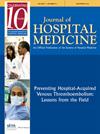Interventions to reduce readmissions after pneumonia hospitalization: A systematic review and meta-analysis
Abstract
Background
Preventable hospital readmissions, reflecting suboptimal healthcare quality and increased costs, highlight the need for evidence to shape healthcare delivery.
Objectives
This systematic review assesses interventions to reduce readmissions following pneumonia-related hospitalizations.
Methods
PubMed, Cochrane Library, and CINAHL were searched from inception to May 29, 2024. English language peer-reviewed studies examining interventions to reduce readmissions after pneumonia hospitalization were selected. Two authors independently extracted data, assessed risk of bias, and evaluated certainty of evidence using standardized assessment tools. When possible, study results were pooled using random-effects models.
Results
Of the 601 articles initially identified, 15 studies met inclusion criteria. Eight interventions were evaluated from eight retrospective cohort studies, five randomized controlled trials, and two pre-post trials. Hospital-based skilled nursing facilities, patient education, early postdischarge follow-up, nutrition supplementation, and a high physician-to-bed ratio were linked to reduced readmissions. Early mobilization also showed a significant reduction in readmissions (pooled odds ratio = 0.84, 95% confidence interval [CI]: 0.75, 0.95; p = .005). Hospital participation in Accountable Care Organizations did not affect readmissions, and pharmacist-involved discharge similarly found no significant impact (pooled odds ratio = 0.66, 95% CI: 0.44, 1.01; p = .06). Risk of bias was high across most studies due to inadequate controlling for confounding variables.
Conclusion
Certainty of evidence was high for early mobilization, low for hospital-based skilled nursing facilities, and very low for pharmacist-involved discharge processes. Small sample size and single-center intervention implementation limited study generalizability. Randomized controlled trials are needed to determine the efficacy of interventions for reducing readmissions after pneumonia hospitalization.





 求助内容:
求助内容: 应助结果提醒方式:
应助结果提醒方式:


